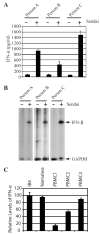Viral transformation for production of personalized type I interferons
- PMID: 20518060
- PMCID: PMC3023146
- DOI: 10.1002/biot.201000038
Viral transformation for production of personalized type I interferons
Abstract
Type I interferons (IFN) are cytokines with many functions and have been widely used to treat many human diseases such as hepatitis C virus infection. Using the viral transformation and priming properties of Epstein-Barr virus, we have developed a system that can produce high levels of "personalized" IFNs, which are produced from the cells of the patient to whom the IFNs are to be administrated. We demonstrate the feasibility of the system. This seems to be the first report for the establishment of a personalized IFN-production system. The personalized IFNs could have a longer circulation time, fewer side effects but higher efficacy. We anticipate that the system can provide an improved form of IFN for medical uses.
Figures


References
-
-
Samuel CE. Antiviral actions of interferons. Clin Microbiol Rev. 2001;14:778–809. table of contents.
-
-
- Sen G. Viruses and Interferons. Annu. Rev. Microbiol. 2001;55:255–281. - PubMed
-
- Rickinson AB, Kieff E. Epstein-Barr Virus. In: Fields BN, Knipe DM, Howley PM, editors. Virology. 3rd Edition Lippinscott-Raven Publishers; Philadelphia, PA: 1996. pp. 2397–2446.
-
- Kieff E. Epstein-Barr virus and its replication. In: Fields BN, Knipe DM, Howley PM, editors. Virology. 3rd Edition Lippinscott-Raven Publishers; Philadelphia, PA: 1996. pp. 2343–2396.
-
- Pagano JS. Epstein-Barr virus: the first human tumor virus and its role in cancer. Proc Assoc Am Physicians. 1999;111:573–580. - PubMed
Publication types
MeSH terms
Substances
Grants and funding
LinkOut - more resources
Full Text Sources

